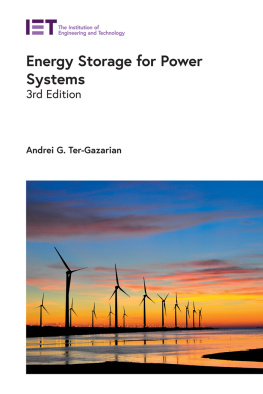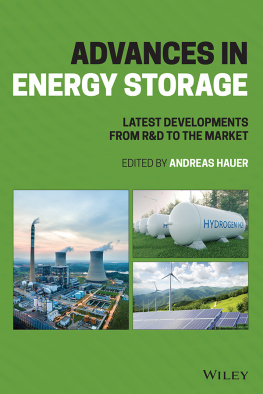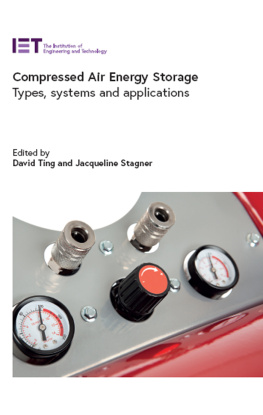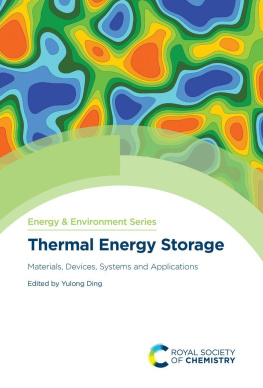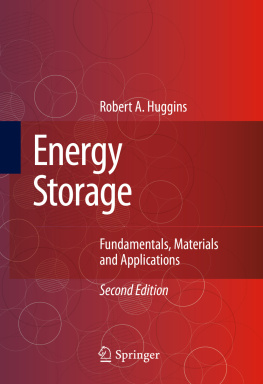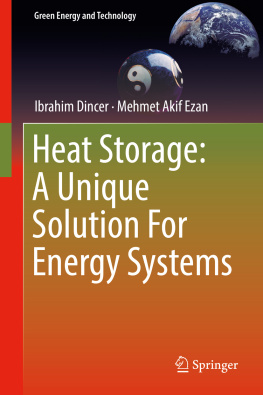Andrei G. Ter-Gazarian - Energy Storage for Power Systems
Here you can read online Andrei G. Ter-Gazarian - Energy Storage for Power Systems full text of the book (entire story) in english for free. Download pdf and epub, get meaning, cover and reviews about this ebook. year: 2020, publisher: Institution of Engineering & Technology, genre: Romance novel. Description of the work, (preface) as well as reviews are available. Best literature library LitArk.com created for fans of good reading and offers a wide selection of genres:
Romance novel
Science fiction
Adventure
Detective
Science
History
Home and family
Prose
Art
Politics
Computer
Non-fiction
Religion
Business
Children
Humor
Choose a favorite category and find really read worthwhile books. Enjoy immersion in the world of imagination, feel the emotions of the characters or learn something new for yourself, make an fascinating discovery.
- Book:Energy Storage for Power Systems
- Author:
- Publisher:Institution of Engineering & Technology
- Genre:
- Year:2020
- Rating:5 / 5
- Favourites:Add to favourites
- Your mark:
- 100
- 1
- 2
- 3
- 4
- 5
Energy Storage for Power Systems: summary, description and annotation
We offer to read an annotation, description, summary or preface (depends on what the author of the book "Energy Storage for Power Systems" wrote himself). If you haven't found the necessary information about the book — write in the comments, we will try to find it.
Energy Storage for Power Systems — read online for free the complete book (whole text) full work
Below is the text of the book, divided by pages. System saving the place of the last page read, allows you to conveniently read the book "Energy Storage for Power Systems" online for free, without having to search again every time where you left off. Put a bookmark, and you can go to the page where you finished reading at any time.
Font size:
Interval:
Bookmark:
Introduction
It is well known that driving in a town with plenty accelerations and braking requires much more fuel than quiet driving outside cities. The main reason is that an internal combustion engine consumes more fuel if uneven loaded or idling. Car industry realised that problem and as a result most of the leading automakers are producing hybrid electric vehicles. Actually, hybrid electric vehicle is a typical example of power system. An internal combustion engine (prime mover) mechanically connected to electric generator forms supply side of a power system. Electric motor represents the demand side. A rechargeable battery between generator and motor represents secondary energy storage. So, the success of hybrid electric vehicles clearly illustrates the importance of energy storage use in electric power systems.
We are accustomed to solar roofs, windmills and electric vehicles and are not aware what do they have in common. All of them are variable sources either of electricity generation or demand. These sources impose additional intermittent load on conventional electric power systems thus increasing electricity cost. The main disadvantage of electricity as an energy carrier is the impossibility of storing it in sufficient quantities. The problem of energy storage becomes more and more crucial with power system development. Thermal power plants all over the world are increasingly being used for cycling operations. At the same time, the share of renewables is growing up. So, the more is renewables share the less effective is thermal power plants generation. But this generation is absolutely essential for any power system. So, wind and solar power impose additional costs on the entire power system. Those costs go up as more variable renewable energy sources are being extensively used. The use of unregulated distributed energy sources and the fact that number of electric cars demanding intermittent charging their batteries intensely grows only aggravates this situation.
All the above problems might be solved by the use of intermediate devices on the power system, which can partly or completely separate the processes of electrical energy generation and consumption. We define secondary energy storage (SES) as an installation specially designed to accept energy generated by the power system, convert it into a form suitable for storage, keep it for a certain time and return as much of the energy as possible back to the power system, converting it into a form required by the consumer.
The use of SES in the form of chemical batteries for bulk power supply is not a new concept: they were the essential part of many electricity utilities at the beginning of the twentieth century. The earliest application of electric storage batteries was in German town, Pennsylvania, in 1890. At that time, electric power systems were primarily direct current (DC) systems and operated isolated from each other. Electric storage batteries were used to fulfil peak electric energy requirements and provide emergency capacity when dynamos, which generated DC, were not in operation. With the expansion of DC electricity systems, the use of batteries became widespread, but development of a competitive alternating current (AC) electricity system changed the trend dramatically. As AC systems evolved and became widely accepted, owing to advances in equipment and systems design that increased their reliability, the use of batteries was discontinued.
Basically, energy is stored at times when the available means of generation exceed demand and is returned when demand exceeds generation. The installation of energy storage plants on electricity utility networks permits the utilities storing energy generated at night by coal-burning or nuclear base-load plants and releases the stored energy to the network during the day when the demand is highest. This reduces the need for gas- or oil-burning turbines and allows for massive penetration of renewable sources.
Energy storage is a net consumer of electric energy. Even though the cycling of energy through storage causes inevitable losses, the overall economic benefits are significant. These benefits are due to:
- Reduced primary fuel consumption because of increased efficiency of operation including conservation and
- Development of new equipment related to, or dependent on, storage techniques.
Of the four forms in which energy is consumed, that is, mechanical, thermal, light and electrical, in practice only thermal energy can be stored by consumers connected to the electricity power system. Energy that is transmitted at the consumers disposal only by means of electricity can be stored locally by distributed energy storage means mostly in the form of electrical energy or heat but due to economies of scale at much higher cost than storage at the supply side. In fact, apart from the economies of scale effect, a producer can use storage to level a load demand in which the effect of time diversity of the peaks of the various consumers is already completely utilised, whereas this cannot be done by a single user. In other words, if each consumer used his own storage means for levelling his own load consumption, it is likely that many storage devices would be in the discharge phase while others would be at standby or even in the charge phase, meaning that overall utilisation of the storage capacity would be low. There is a certain hope that the situation might change by using smart grid and demand response techniques. In this case, distributed energy storage concept would become attractive. Among consumers, only isolated users who cannot be connected to the electricity power system, owing to distance, and electric vehicles, owing to their forced autonomy, can conveniently store energy themselves, as they already do for energy generation.
The International Energy Agency (IEA), in its 2008 Baseline scenario, estimated a worldwide need for over 250 GW of new coal-fired and gas-fired power plant capacity, per year, up to 2050. Despite the fact that the IEA has decreased their figures, the demand for electric energy is considerably growing. To avoid an environmental catastrophe, it is necessary to replace much of the proposed conventional power plants with renewable generation and storage.
Renewable energy sources are already extensively used in many power systems. However, most renewable sources such as the photovoltaic and the wind depend on storage facilities, since these sources are variable throughout the day and through the year and hence are unable to provide a controllable energy supply. Unlike fuels, renewables cannot be directly stored, so they either require secondary storage systems or have to be used in electrical power systems with sufficient reserve capacities installed on conventional power plants.
Storage means usually have characteristics very different from those of generation means. Therefore, energy storage can perform other functions, complementary to those of the generating equipment and very important from both technical and economical points of view. These functions are considered in this book. Part II of this book expands upon the different storage techniques. The problem of selecting the most appropriate composition of a mixed generating and storage structure appears immediately to be the most important problem for the power system engineer. Therefore, Part III of this book is devoted to this challenging problem that can be solved provided the information on power system requirements for energy storage, as well as storage equipment technical and economical parameters, are known. Part IV of this book is devoted to the problem of distributed energy storage integration in an electric power system comprising renewable energy sources and electric car batteries swap and charging stations.
Font size:
Interval:
Bookmark:
Similar books «Energy Storage for Power Systems»
Look at similar books to Energy Storage for Power Systems. We have selected literature similar in name and meaning in the hope of providing readers with more options to find new, interesting, not yet read works.
Discussion, reviews of the book Energy Storage for Power Systems and just readers' own opinions. Leave your comments, write what you think about the work, its meaning or the main characters. Specify what exactly you liked and what you didn't like, and why you think so.

